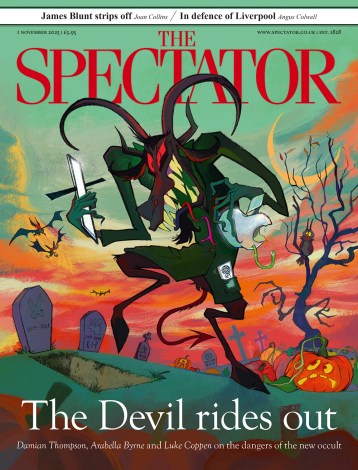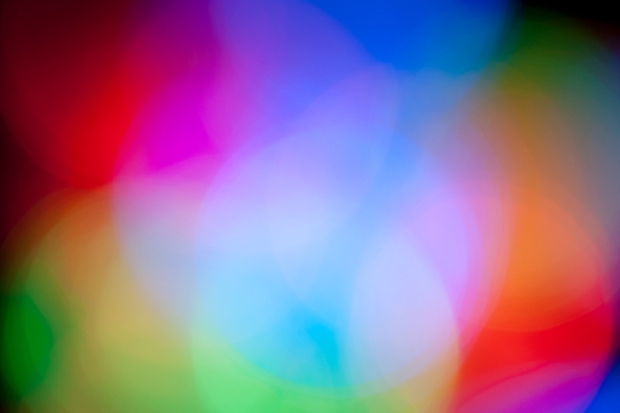Aldous Huxley reported his first psychedelic experience in The Doors of Perception (1954), a bewitching little volume that soon became the Newest Testament among the happening people. One spring morning in 1953 the 58-year-old Englishman ingested four-tenths of a gram of mescalin in his Hollywood garden and waited for the visionary moment. When he opened his eyes he saw pure California neon dust. ‘I was seeing what Adam had seen on the morning of his own creation.’
Evelyn Waugh was not alone in thinking that Huxley had gone bonkers in his American exile. (‘Huxley has done more than change climate and diet.’) He had been introduced to psychedelic drugs by the English psychiatrist Dr Humphry Osmond, a pioneer in the use of mescalin in the treatment of alcoholics (Cary Grant, among others, was prescribed LSD for his drink addiction). As Rob Chapman relates in his huge, encyclopaedic history of LSD and its cultural ramifications, Psychedelia and Other Colours, it was Dr Osmond who, in 1957, coined the word ‘psychodelic’ (mind-opening). This was later amended to ‘psychedelic’ in an effort to remove the psychotic connotations of LSD for which the cranky, drug-legalising Harvard professor Timothy Leary was partly responsible.
In 1969, the story goes, the ‘alternative snake-oil salesman’ Leary telephoned Huxley’s widow to say that the Grateful Dead had arrived in Los Angeles and would she put the band up? A concert violinist, Laura Huxley had never heard of the freaky rock‘n’rollers. (‘We should be grateful to be alive, not dead,’ she told Leary.) The Dead were set to descend with their fuzzboxes and feedback, but Mrs Huxley shooed them away. Her husband would not have cared for the Dead’s weird sound, preferring instead Renaissance madrigals.
Between 1953 and his death in 1963, Huxley took acid some ten or 12 times only. The psycho-chemical expeditions were self-experiment in the name of science, yet Huxley was credited with setting in motion an international psychedelic movement causing the mental derangement of millions of people. Jim Morrison and his humourless California band the Doors named themselves after The Doors of Perception; the Beatles included Huxley’s photograph on their Sergeant Pepper album sleeve. Whether he liked it or not, Huxley was hip.
Chapman, a Mojo magazine contributor, concentrates on music. Alexander Scriabin’s proto-psychedelic composition The Mysterium, written in 1915, involved swirling coloured lights and patchouli-based perfumes wafting over the orchestra pit. From Scriabin it was a short step to the Pink Floyd’s light-show concerts in 1960s underground London, says Chapman. Syd Barrett, the Floyd’s Byronic founder member, borrowed from a tradition of English music hall and the rueful melancholy of Edward Lear to write the group’s shimmering first album, The Piper at the Gates of Dawn, a Scriabin-like synesthesia of colour and sound. In a fascinating chapter, Chapman considers the influence of music hall on other psychedelic bands such as the Zombies and Cream. A dark side to British psychedelia began to show in their faux-Victorian tales of drunkenness and child death.
In California, the psychedelic movement turned sour with the Manson family murders of 1969, though bad magic had long been hatching beneath the palms. Forever Changes, the great 1967 album by the LA band Love, combined psychedelic mariachi riffs with allusions to blood transfusions and a sickness in the city. Los Angeles would have to wait until the 1980s for a uniquely black music: rap. However, Chapman makes a good case for African-American psychedelia in the shape of Jimi Hendrix, Arthur Lee (of Love) and, later, George Clinton of the prankster funk outfit Parliament.
Meanwhile, as Aldous Huxley lay dying in his Hollywood exile in 1963, his Italian wife Laura waved him on his final trip with a double dose of LSD. (‘Light and free you let go, darling. And you are going toward the light…’) President John F. Kennedy had been assassinated in Dallas earlier that afternoon; ignorant of the event, Huxley asked for the drug to be administered in extremis. The hippie heyday was not far off, yet no one knew for sure whether Huxley’s LSD ingestions were exercises in pure and applied pointlessness — or worse. Psychedelia and Other Colours, a work of rare scholarship and insight, opens a window onto a much misunderstood multicoloured era.






Comments